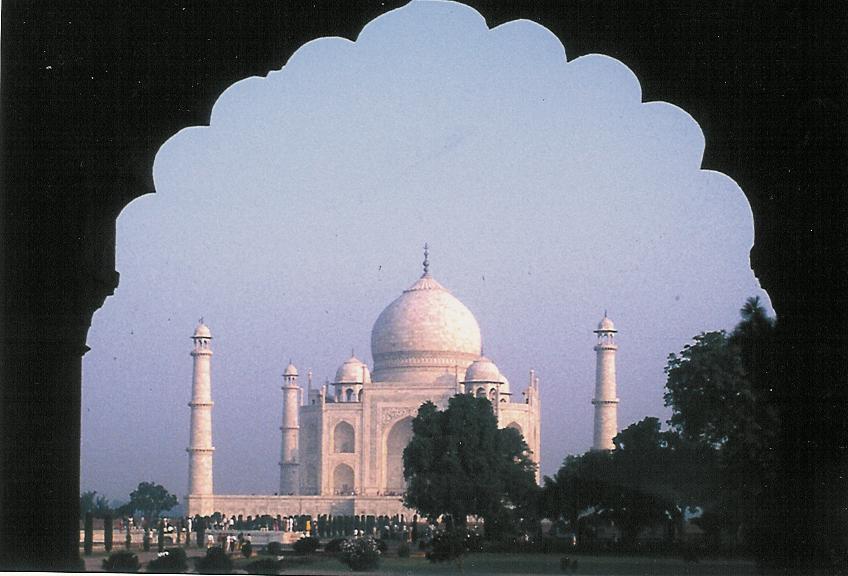
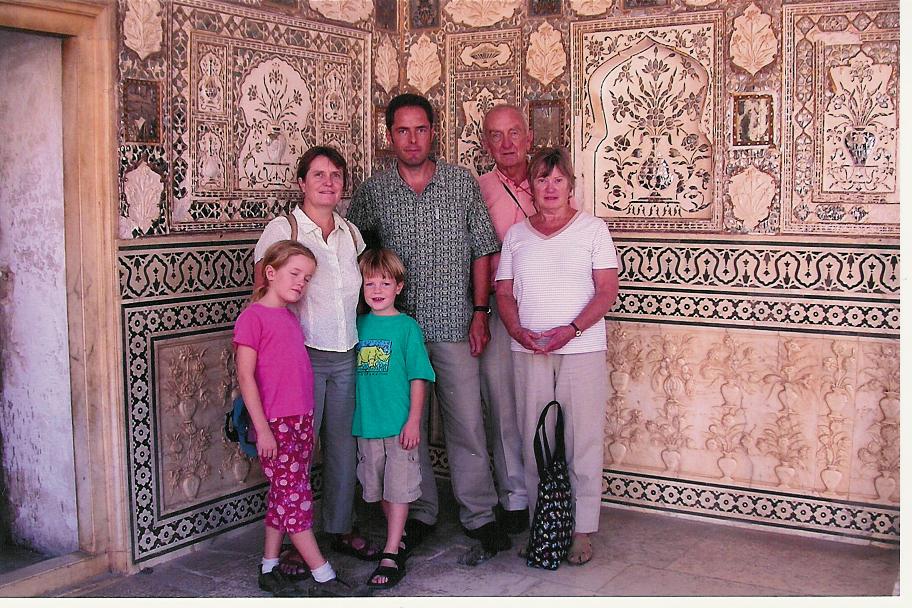
India (2004)
Taj, Tigers and Palaces
We have always wanted to see India. We got as far as Thailand in 1993 when religious rioting in India forced us to cancel our first trip. When Jill and Trevor asked us to join them along with our grandchildren, Isabel and Miles, on a trip to India we jumped at the chance. It was a great way to celebrate our140th birthday.
 |
 |
Taj Mahal - Agra With the Saxtys in India
India is more crowded, dirty, noisy and chaotic but, at the same time, more fascinating, colorful and exciting than we could have ever imagined before we took our trip. One travel writer referred to traveling in India as an assault on the senses. Even though we had spent months before our trip reading every book and watching videos of every movie about India that we could get our hands on, nothing could have totally prepared us for the actual experience. Visiting India may not be for everyone. It is a journey of astonishment – both good and bad – rather than an easy holiday in the sun. We were glad that we had come.
India – The Country and its History. With over one billion people, India has three times as many people than the United States, living in a county which is only one-third the size of the U.S. With its growing population, it will surpass China as the world’s largest country in just five more years. It is a kaleidoscope of religions, languages, ethnic backgrounds and social strata. The Hindus constitute the majority religion with 80 % of the population; the Moslems make up 12 %; Sikhs, Christians, Parsi, and Buddhists account for much of the rest. Hindi is the predominant language among the seventeen officially recognized languages spoken in India. English widely spoken for commercial and diplomatic purposes, a carryover from a century and a half of British rule. Regional loyalties remain very strong; our guide said several times that the Indian people have not yet developed a strong national identity, but somehow the fragile democracy which was instituted when India became independent in 1947 has managed to survive.
The history of India can be traced back over 3,000 years. Separated from the rest of the world by the Himalayas in the North and the Indian Ocean in the south, it was long a country of separate tribes and city-states. Subjected to raids from the North from the descendents of Genghis Khan, the country was ultimately conquered by the Moghuls, a Moslem people from what is now Afghanistan, who poured through the Khyber Pass and ruled the country from 1526 to 1858 leaving behind an architectural legacy which can be found in the beautiful mosques and palaces throughout the region including the incomparable Taj Mahal.
The British arrived in the middle of the 18th century first with the East India Trading Company and then in 1857, following the Indian Mutiny, as a full colonial power. Although they are credited with creating many of the institutions and infrastructures that form the backbone of modern India, they ruled with a colonial arrogance, which led to the movement for national independence, led by Mahatma Gandhi. India gained its independence at midnight on August 15, 1947.
Tour. Billed as a family-oriented adventure travel experience, our tour was tailored for younger travelers. The days were kept short; travel between destinations was held to half-day drives every second day; swimming pools were included in several of our hotels; and the activities included such things as a train ride, a tiger-spotting expedition and an elephant ride, designed to appeal to our six and nine year old grandchildren - not to mention their seventy year old grandparents as well.
In addition to Jill and her family, our traveling companions included two British families with children of their own ranging in age from eight to sixteen. Our group numbered fifteen in total – eight adults and seven children. As kids tend to do, the seven children made friends quickly and by the second evening, they were all sitting together at one end of the dinner table leaving the adults at the opposite end. We were accompanied by a Rajasthani guide named Devender Singh for the entire trip.
Our travels were centered in Rajasthan – a name which means “Land of Princes” and encompasses the former city-states of the Hindu Rajput rulers. It is a land, larger that France, which is dotted with castles, temples and fabulous palaces and where the men wear scarlet turbans and the women wear colorful saris of in iridescent red, yellow and orange and are laden with jewelry. The hilltops are crowned with battle-worn forts echoing the area’s warring history. Rajasthan is the land of the fabled Maharajas that ruled over their princely states, living lives of opulence and luxury rich with palaces, jewels, private armies, hundreds of servants and several wives. Some chose to develop their lands, educate their subjects and play the role of enlightened despots. Others preferred to play polo, shoot tigers and adopt the life of a playboy.
Our itinerary took us from Delhi to Bundi to Jaipur to Agra and back to Delhi. We covered about 700 miles. Our group traveled by train, bus, open topped safari van and rickshaws – both motorized and pedal-powered It was on one of the motorized rickshaws the we took a death defying ride through the crowded streets on our first evening in Delhi.
We stayed in locally-run accommodations – six nights in hotels and four nights in haveli, which were homes of princes or wealthy merchants, which had been converted into tourist accommodations. What they may have lacked in amenities, they more than made up for in charm. Built around a courtyard, the haveli were isolated by a high wall from the crowded streets just outside the gate. The colorful hand-painted murals in the rooms, the heavy wooden furniture, the displays of old armor and portraits and photographs of the previous occupants gave us a sense of what life must have been like in the days of the maharajas. Our first overnight stay in a haveli was in the town of Bundi, where Rudyard Kipling lived when he wrote Kim, his classic novel of India during the British Raj. The India of Kipling’s stories seemed to exist just outside the gates of our haveli - the deafening street markets, the ever-present sacred cows, the lumbering bullock-carts and the throngs of hawkers, snake-charmers, yogi and beggars. One expected Kim to come darting out of an alleyway at any moment.
We traveled in a comfortable, 30 person bus – large enough so that everyone could have their own window seat. Apart from an occasional game of cards with Isabel, most of the time was spent with our eyes glued to the window watching all of the fascinating sights passing by. Traveling on the roads in India is an unforgettable experience. Busses, trucks, farm tractors, ox carts, camel carts, mopeds, bicycles and pedestrians all share the same road with any number of animals – cows, goat, sheep, dogs, pigs and even an occasional elephant.
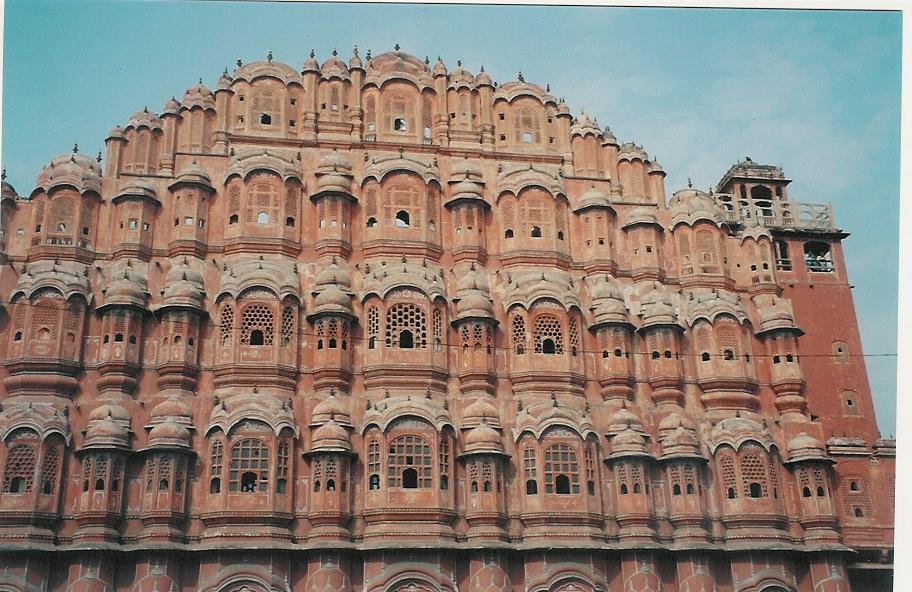 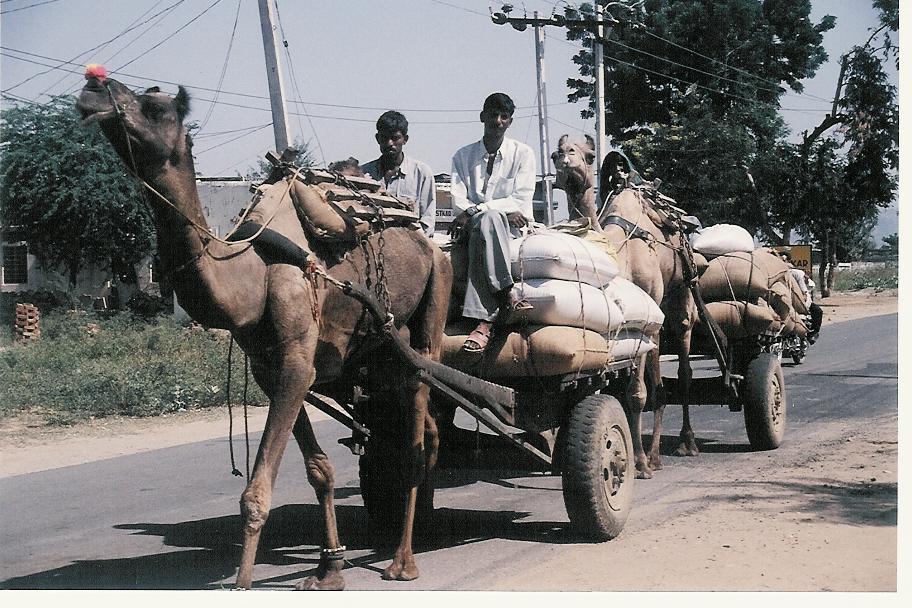 |
Palace of the Winds - Jaipur Charlie, the Red Nosed Camel
Most of the highways are two lanes without any shoulders and the prevailing traffic code is “might makes right- of-way”. Trucks and busses take over the middle of the road while bikes and pedestrians scramble off the roadside for cover. Only the sacred cows are given a deferential right-of-way. I sat near the front of the bus on the first leg, “helping” our turbaned, steely-eyed Sikh driver avoid head on accidents by slamming down my imaginary brakes every few minutes, when a collision seemed inevitable. I also offered “mental” advice on when and when not to pass in the face of oncoming traffic, which he totally ignored. At the end of the day I was exhausted until our guide explained that our safe arrival was more a matter of our karma rather than anything the driver or I did, leaving me to wonder what kind of things I might have done in my previous lives. Those hours on the roads were one of the highlights of the trip for me.
Highlights. When I asked Isabel and Miles what their highlights were, they answered quickly: the train ride, spotting a tiger in the jungle and riding on the back of an elephant up to Amber Fort:
The Train to Rajasthan. The railway system in India, one of the legacies of the British Raj, is the biggest in the world in terms of passenger miles. It is also the country’s largest employer with over 1.5 million staff. Over ten million people use trains every day. It seemed like all ten million were there at the Delhi railroad station when we arrived to board our train to Kota. It was mass chaos as we worked our way through the throngs of people at the station including hundreds who make the homes on the station platform – sleeping and performing their daily ablutions there. There were vendors, beggars, holy men, women in saris, men in business suits and people of all kinds crowding the platforms.
Turban-clad porters, each with two of our suitcases balanced on their heads, carried our bags to the train car, where we searched for our seat assignment on computer print-outs mounted on near the door of each car. We traveled in a second class car with open, six person compartments, three people on each side facing each other. We stored our luggage on a fold-down bunk above our heads, which worked fine until an Indian passenger quietly climbed up there above us, re-arranged the bags and went to sleep.
The kitchen car was just in front of ours. We could watch the cooks working over open coal stoves preparing tea, soup and curried rice, which the porters carried down the aisles to sell to the passengers. The bathrooms were the classic hole in the floor variety and open to the tracks whizzing by underneath. Without being any more descriptive, Miles agreed that he was happy that he had learned to pee standing up a few years ago. We played a few card games with the kids but spent most of our six hour journey looking out the window as the train rolled through the countryside in Rajasthan.
Tiger Spotting. Ranthambore National Park is famous for its tigers and plays a key part of India’s “Save the Tigers” Program. The four hundred square mile park is home to about forty tigers and a host of other animals including jaguar, deer, sambar, wild boars, mongooses, and crocodiles.
We made two game drives into the park looking for tigers, but were warned that they are nocturnal, elusive and not often spotted. In the first morning drive, we did see a tiger hidden in some brush and, although we could only get glimpses of a tail, a paw and a flank through the thick brush we did decide to count it as “half a tiger”. In the afternoon drive as we were about to leave, a “whole tiger”, as Miles later described the sighting to his dad, came out of the jungle and walked slowly past us, not more than ten feet away, on her way to a lunch date with the deer. It was a thrilling moment and even the guides were excited at this rare, close-up encounter. As one enthusiastic guide pointed out to the kids, there are only six thousand wild tigers left in the world, so they should be sure to always remember this special moment.
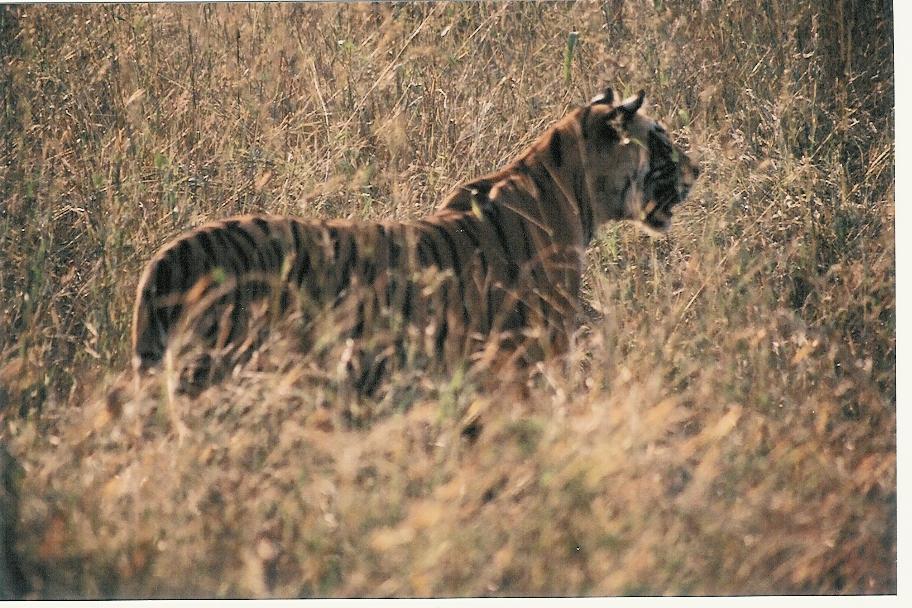 |
 Ti Ti |
Tiger in the Wild _ Ranthambore National Park Elephant Ride to Amber Fort - Jaipur
Elephant Ride. I suppose that we could have walked up to the entrance of the great Amber Palace outside of Jaipur – but why walk when you can ride an elephant? Clearly there for the tourists, several dozen highly decorated elephants lined up to take the visitors on the fifteen minute climb up to the palace gate. With a driver (mahout) guiding the elephant from his perch on the elephant’s head, the riders are seated, two to a side and facing outward, in a seat (howdah) on top of the elephant’s back. The slow, lumbering, side-to-side gate takes a while to get used to as does the twelve foot distance to the ground but the ride was a fun experience and a great photo opportunity.
Palaces. Each day’s itinerary included a visit to one of the many palaces that were built throughout Rajasthan during the golden era of the maharajas, each one more splendid than the last. Among the most memorable were: the Tagagarh Fort, built in the 14th century, now stands deserted and little cared for above the town of Bundi. Since Bundi is relatively remote and off the beaten track – with no railways or hotels – this magnificent palace- fortress remains unvisited by most tourists. Our local tour guide was the grand- nephew of the last maharaja to live in the palace. The City Palace, in the heart of the Pink City of Jaipur was the town residence of the maharaja of Jaipur. The present royal family occupies only certain quarters while most of the palace now serves as a museum of the art, jewelry and clothing of its former inhabitants. Also in Jaipur, the Palace of the Winds stands five stories high but is little more than a façade, measuring only five or six feet in thickness. It provided a series of balconies in which women from the palace were able to stand and look through finely carved window screens down onto the street without exposing themselves to public view.
Rising from a steep hill slope outside of Jaipur, with glorious views of the countryside below, the Amber Fort was the palace of the maharaja before they moved the capital to Jaipur. Built in 1569 by Akbar, the greatest of all the Moghul rulers, the palace at Fatehpur Sikri was abandoned just sixteen years later due to the lack of a sufficient water supply. This mighty ghost palace remains unchanged through the years just as it was built over four hundred years ago. The Red Fort in Agra, built by Akbar in 1570 to replace the palace at Fatehpur Sikri, looks out over the River Yamuna to the Taj Mahal in the distance. It was in the Red Fort that Shah Jahan, who built the Taj Mahal, lived out his final days imprisoned by his son after a palace coup, gazing out at the white marble sepulture than entombed his wife.
Taj Mahal. It was probably not a coincidence that the tour planners saved the Taj Mahal for our final day. It was a fitting finale to our ten day trip to India. To many people, the Taj is a symbol of India. It’s curving, gently swelling dome, its four graceful minaret towers and the square base upon which they rest is a familiar image from hundreds of brochures and travel books. Our expectations were high as we saw the Taj for the first time and we were not disappointed. The Taj Mahal is undoubtedly one of the most spectacular buildings in the world.
The government has wisely isolated the monument from the deteriorating effects of car and bus emissions by establishing a two mile perimeter around the Taj Mahal which can only be accessed by battery-driven vehicles. We scheduled our visit for the early morning hours to avoid the crush of mid-day tourists and to catch our first glimpse of the majestic building in the quiet, peaceful early hours.
The history behind the construction of the Taj Mahal is as romantic as the building itself. In 1612, a beautiful, young woman named Mumtaz Mahal was married to Shah Jehan, the fifth mughal emperor. The marriage was a real love match. Mumtaz was her husband’s inseparable companion on all his journeys and military expeditions. She was his comrade, his counselor and inspired him to acts of benevolence to the poor and needy. She bore him fourteen children and died in childbirth with the birth of their last child. Overpowered by grief, Shah Jehan was determined to perpetuate her memory for immortality and decided to build his beloved wife the finest sepulcher ever built – a monument of eternal love. After twenty-two years and the combined effort of over twenty thousand workmen, the complex was finally completed in 1648 just over 350 years ago.
We spent several hours at the complex taking pictures, admiring the elaborately carved designs in the marble facades and just quietly absorbing the moment in the presence of one of the world’s foremost wonders. We returned that afternoon from Agra to Delhi and prepared for our flight home the next day.
Having come to India by flying across the Pacific, we decided to complete the return journey by flying home across the Atlantic. If we had any doubts before this around-the-world trip about the earth being round, I think we can say now with some certainty that those doubts were groundless. Phineas Fogg made his trip “Around the World in Eighty Days”. Valerie and I were able to beat his time by a good two months. We made it “Around the World in Eighteen Days”.
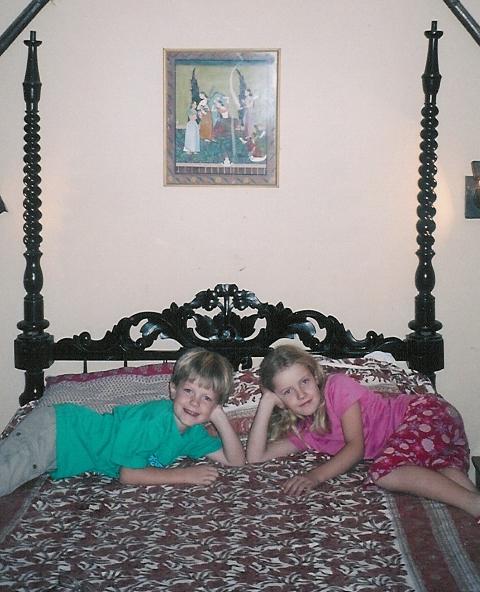 |
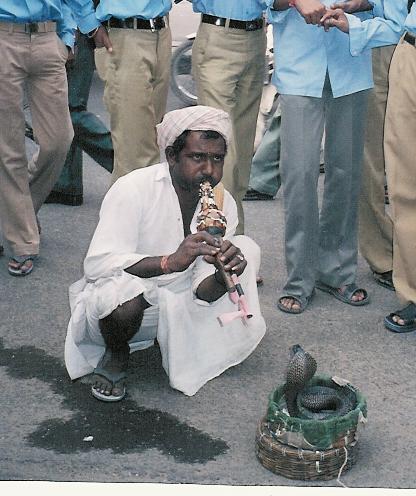 |
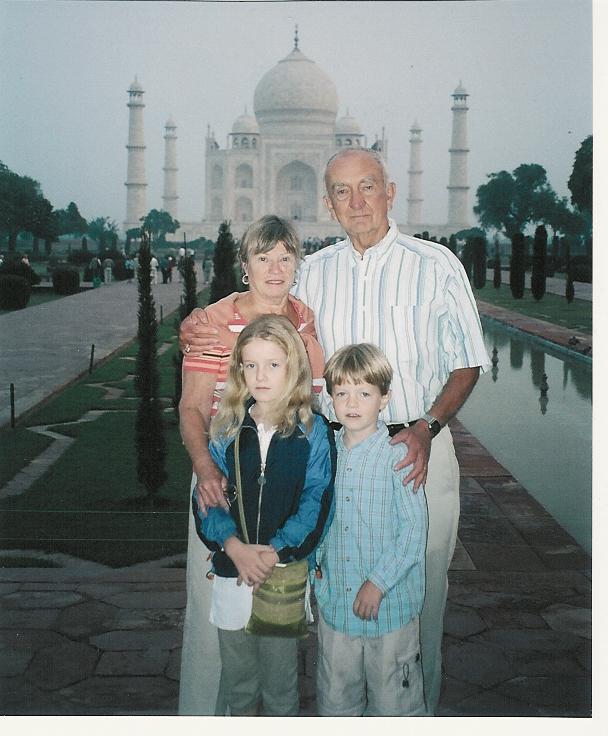 |
Haveli - Miles and Isabel Snake Charmer Taj Mahal with the Grandchildren
We summed it up when we came home:
Train to Rajasthan – 900 rupees
Tiger Spotting – 500 rupees
Elephant Ride – 250 rupees
Taj Mahal - 750 rupees
Seeing India through the Eyes of our Grandchildren –PRICELESS !!!